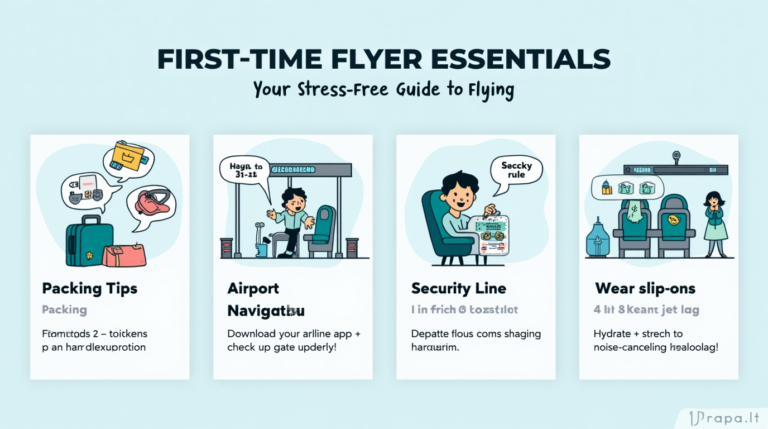International travel documents checklist
Table of Contents
I’d be happy to create a comprehensive 2000-word blog post based on the outline you’ve provided about international travel checklists. Here it is:
Creating Your International Travel Checklist: The Ultimate Guide
Planning an international trip is exciting, but the preparation can feel overwhelming. Between securing the right documents, understanding entry requirements, and making sure you’ve packed everything you need, there’s a lot to keep track of. That’s why creating a comprehensive international travel checklist is essential for stress-free travel. This guide will walk you through everything you need to know to prepare for your next overseas adventure.
Why You Need a Travel Checklist
International travel involves numerous moving parts that can easily slip through the cracks without proper organization. A well-crafted checklist ensures you don’t forget critical documents or items, helps you navigate complex entry requirements, and provides peace of mind as you embark on your journey.
I. Methods for Creating an Effective Travel Checklist
The first step in your travel preparation is choosing the right method for creating and maintaining your checklist. Your choice should align with your personal preferences and travel style.
A. Simple List in a Notes App
For travelers who prefer minimalism and accessibility, a basic list in your smartphone’s notes app offers simplicity and convenience.
Advantages:
- Always accessible as long as you have your phone
- Easy to update on the go
- No additional downloads required
- Can be shared via text or email
Best practices:
- Create separate sections for documents, clothing, toiletries, and electronics
- Use the checklist feature if available to track completed items
- Back up your notes to cloud storage
- Consider taking a screenshot as a backup
B. Checklist in a Word Document or Spreadsheet
For more detailed organization, consider creating your checklist in applications like Google Sheets, Microsoft Excel, or Word documents.
Advantages:
- Greater customization options
- Ability to create multiple sheets or sections
- Easy sharing with travel companions
- Can be exported as a PDF for offline access
Best practices:
- Download the relevant app on your phone before departure
- Create a backup hard copy in case of technical issues
- Use conditional formatting or color-coding for priority items
- Create separate tabs for different aspects of your trip (documents, pre-departure tasks, packing)
C. Travel Checklist Apps
Dedicated travel apps offer specialized features designed specifically for travelers.
Popular options include:
TripIt: Perfect for comprehensive trip organization
- Syncs with your calendar
- Securely stores travel documents
- Creates detailed itineraries
- Provides real-time flight updates
Pack, PackPoint, or Packr: Specialized packing list applications
- Suggest items based on destination, weather, and activities
- Allow customization of lists
- Save frequently used lists for future trips
- Share lists with travel companions
Best practices:
- Download and test your chosen app well before departure
- Ensure all features work without an internet connection
- Back up important information in a secondary location
- Familiarize yourself with all features to maximize benefits
B. Timing for Preparation
When to begin your travel preparations can significantly impact your stress levels and readiness.
Six months before departure:
- Check passport validity
- Research visa requirements
- Look into vaccination requirements
- Begin researching travel insurance options
Three months before departure:
- Apply for necessary visas
- Schedule required vaccinations
- Book major transportation and accommodations
- Start researching local customs and language basics
One month before departure:
- Confirm all bookings
- Notify your bank and credit card companies
- Arrange for pet/plant care and mail collection
- Begin creating your detailed packing list
Two weeks before departure:
- Fill prescriptions
- Prepare digital and physical copies of important documents
- Download necessary apps and offline maps
- Start gathering items on your packing list
Starting your preparation early—ideally six months in advance—ensures you have ample time to address any unexpected issues that may arise.
II. Documents to Consider for Your International Travel Checklist
Documentation requirements form the foundation of international travel preparation. Missing or incorrect documents can result in denied boarding or entry to your destination country.
A. Essential Travel Documents
1. Passport
Your passport is the most critical document for international travel.
Key considerations:
- Validity requirements vary by country, with many requiring 3-6 months validity beyond your intended stay
- Some countries require at least two blank pages for visa stamps
- Keep digital and physical copies separate from your original passport
- Check processing times for renewals, which can range from 6-12 weeks during peak travel seasons
2. Visa
Visa requirements depend on your citizenship and destination country.
Important factors:
- Research requirements well in advance as processing can take weeks or months
- Student or business travelers often need additional documentation
- Multi-country trips may require multiple visas
- Some countries offer e-visas or visas on arrival; confirm eligibility and requirements
3. Birth Certificate or Other Proof of Citizenship
While not always required, these documents provide backup identification.
When they’re needed:
- Children under a certain age may need birth certificates
- Dual citizens may need proof of citizenship for specific countries
- Useful as secondary identification if your passport is lost or stolen
- May be required for certain visa applications
4. Consent Form for Travel with a Minor
If traveling alone with a child, documentation proving parental consent is often required.
Requirements typically include:
- Notarized letter from the absent parent(s) giving permission
- Contact information for both parents
- Travel dates and destinations
- Child’s birth certificate
Always check specific requirements with the embassy or consulate of your destination country.
5. International Driver’s Permit
Essential if you plan to drive abroad, this permit translates your driver’s license information into multiple languages.
Key points:
- Valid for one year
- Must be carried alongside your regular driver’s license
- Available through organizations like AAA in the US
- Not a standalone document but a translation of your existing license
6. Proof of International Travel Medical Insurance
Health insurance is increasingly required by destination countries.
What to know:
- Your domestic health insurance likely won’t cover international medical care
- Some countries explicitly require proof of coverage for entry
- The U.S. Department of State recommends coverage for all international travelers
- Look for policies that include emergency evacuation coverage
7. Return Ticket
Many countries require proof that you plan to leave.
Why it matters:
- Immigration officials may deny entry without proof of departure
- Flexible tickets may be worth the additional cost
- Digital copies should be accessible offline
- Some countries specify the maximum length of stay allowed
8. List of Medications
Traveling with medications requires advance planning and documentation.
Best practices:
- Carry a list of all medications with generic names
- Include physician documentation explaining medical necessity
- Research destination country regulations—some common US medications are illegal elsewhere
- Keep medications in original packaging with prescription labels
9. COVID-19 Travel Documents
Despite evolving regulations, COVID-19 documentation remains relevant for international travel.
Potential requirements include:
- Vaccination certificates
- Testing results
- Health declarations
- Specialized travel insurance
B. Documents Needed to Travel to the USA
If your travels include entering the United States, documentation requirements vary based on citizenship and entry method.
1. U.S. Citizens Entering by Air
Acceptable documents:
- Valid U.S. Passport
- Trusted Traveler Program Card (Global Entry, NEXUS, SENTRI, FAST)
- U.S. Military ID (when traveling on official orders)
- U.S. Merchant Mariner Document (when traveling on official maritime business)
Children, regardless of age, must have their own passports.
2. U.S. Citizens Entering by Land or Sea
Acceptable documents:
- Valid U.S. Passport
- Passport Card (less expensive but valid only for land and sea travel)
- Enhanced Driver’s License (EDL)
- Trusted Traveler Card
- U.S. Military ID (when traveling on official orders)
- U.S. Merchant Mariner Document
- Form I-872 American Indian Card
- Enhanced Tribal Card (ETC)
Children may use birth certificates or proof of citizenship in certain circumstances.
3. U.S. Citizens Entering from Closed-Loop Cruises
Cruises that begin and end at the same U.S. port have slightly different requirements:
- Birth Certificate and Government-Issued Photo ID are typically sufficient
- However, the cruise destination may still require a passport
- Passport is strongly recommended in case of emergency disembarkation at a foreign port
4. Lawful Permanent Residents of the U.S.
Required documents:
- Permanent Resident Card (Green Card)
- Reentry Permit if absent from the U.S. for more than one year
- Returning Resident Visa if absent for more than two years
5. Canadian, Bermudian, and Mexican Citizens
Special provisions exist for citizens of countries bordering or near the United States, with specific passport and identification requirements based on entry method and purpose of visit.
6. Citizens of All Other Countries
Standard requirements:
- Valid Passport
- Valid U.S. Visa or ESTA approval if eligible
- International Driver’s Permit if planning to drive
III. COVID-19-Related Documents for Your Checklist
While requirements continue to evolve, COVID-19 documentation remains an important consideration for international travelers.
A. Determining Necessary Documents
Requirements depend on several factors:
- Current COVID-19 case rates
- Vaccination rates in origin and destination countries
- Government policies, which can change with little notice
- Variant concerns
B. Potential Documents
1. Negative COVID-19 Test Results
Testing requirements vary widely:
- Verify accepted test types (PCR, antigen, etc.)
- Confirm timing requirements (typically within 1-3 days of travel)
- Understand documentation format requirements
- Plan testing logistics at your destination for return travel
2. Vaccine Card or Proof of Vaccinations
Vaccination documentation has become standard for international travel:
- Many countries require full vaccination for entry
- Some destinations require booster doses
- Digital vaccination certificates may be preferred or required
- Requirements for children vary significantly
3. Health Report or Declaration
Additional health documentation may include:
- Online health declarations prior to travel
- Health screening questionnaires
- Physician statements for those with medical exemptions
- Contact tracing information
4. Proof of Travel Insurance with COVID-19 Coverage
Specialized insurance coverage is increasingly important:
- Some countries mandate insurance covering COVID-19 medical expenses
- Certain destinations require purchase of government-approved policies
- Coverage should include quarantine expenses and trip disruptions
- Verify coverage limits and claim procedures
C. Additional Considerations
Beyond documentation, prepare for COVID-19 protocols at your destination:
- Research local mask and social distancing requirements
- Understand quarantine protocols if you test positive
- Pack sufficient masks and sanitizing supplies
- Have a contingency plan if you need to extend your stay unexpectedly
IV. Understanding Travel Restrictions vs. Requirements
The distinction between travel restrictions and requirements is crucial for international travelers.
A. Requirements
Requirements refer to the necessary steps and documentation needed for entry:
- Specific documents
- Testing or vaccination protocols
- Registration processes
- Quarantine obligations
These are conditions that, when met, allow entry into the country.
B. Restrictions
Restrictions determine whether you’re permitted to enter a country at all:
- Complete travel bans from certain countries
- Essential travel only policies
- Citizenship or residency limitations
- Specific visa category restrictions
No amount of documentation can overcome a restriction if you fall into a prohibited category.
C. Importance of Research
The dynamic nature of international travel regulations demands thorough research:
- Check official government websites for your destination country
- Verify information with your airline or transportation provider
- Subscribe to travel advisories from your home country
- Consider working with a travel professional for complex itineraries
Final Thoughts: Making Your Travel Checklist Work for You
A well-crafted international travel checklist does more than help you remember important documents—it provides a framework for a smooth, stress-free journey. By starting early, choosing the right organization method, and staying informed about changing requirements, you set yourself up for travel success.
Remember that flexibility remains the most valuable trait for international travelers. Regulations change, flights get delayed, and unexpected challenges arise. Your checklist serves as a guide, but adaptability ensures you can navigate whatever comes your way.







